Business Environment Report: Primark, Stakeholders, and Economies
VerifiedAdded on 2020/01/16
|28
|6920
|209
Report
AI Summary
This report provides a comprehensive analysis of the UK business environment, examining various organizational types, with a specific focus on Primark. It identifies the purposes of different organizations, including limited companies, sole traders, co-operatives, and franchises, and then delves into Primark's role as a retailer. The report explores Primark's stakeholder objectives, including shareholders, employees, suppliers, customers, and workers, and discusses how Primark meets these objectives. Furthermore, it outlines Primark's organizational responsibilities, encompassing legal, ethical, and societal considerations, and details the strategies employed to fulfill these responsibilities, such as ethical practices and CSR initiatives. The report also examines different economic systems, specifically the planned economic system of Cuba and the mixed economy of the United Kingdom, providing insights into resource allocation and decision-making processes. The report touches upon how market forces and EU legislation impact businesses, offering a well-rounded view of the business environment.
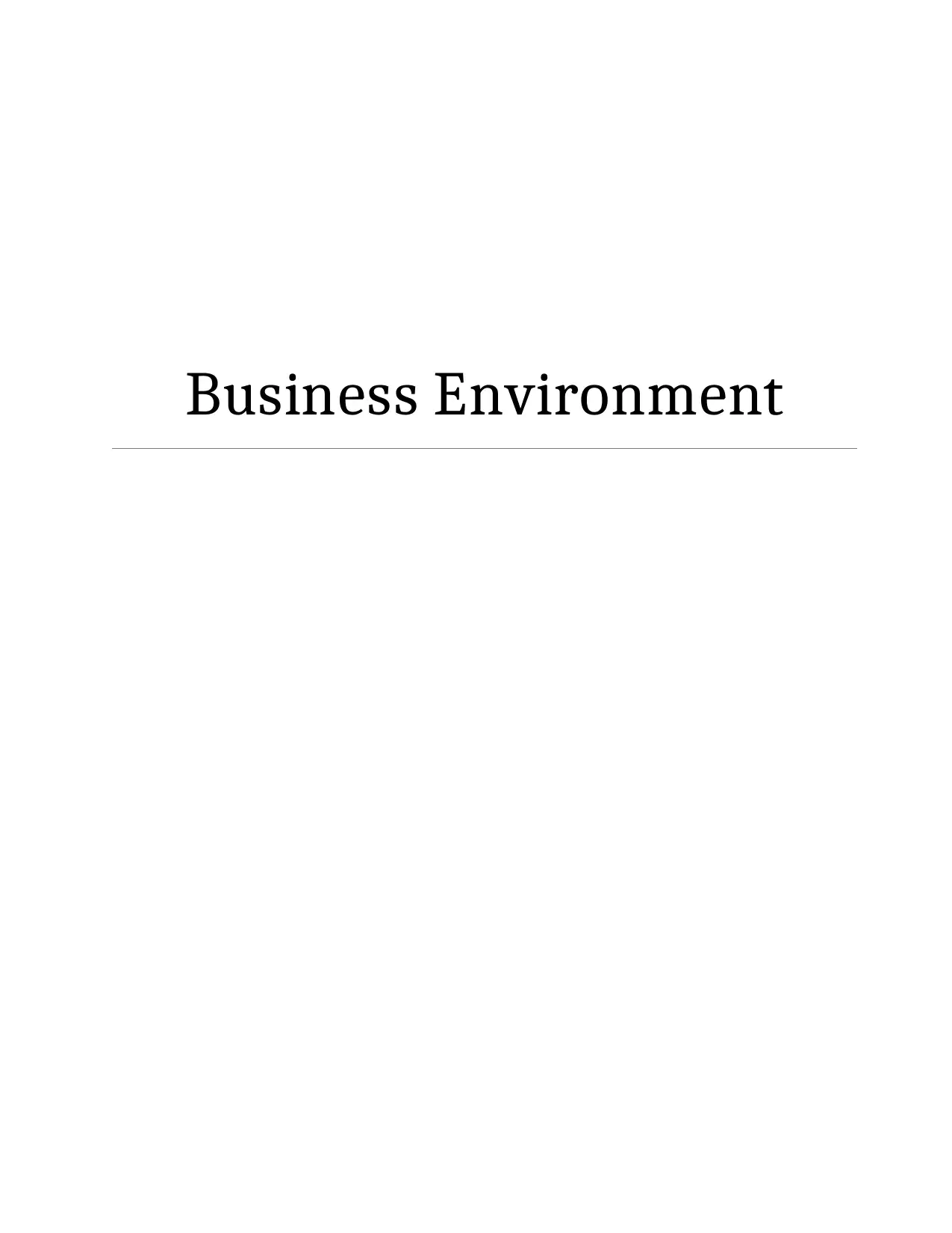
Business Environment
Paraphrase This Document
Need a fresh take? Get an instant paraphrase of this document with our AI Paraphraser

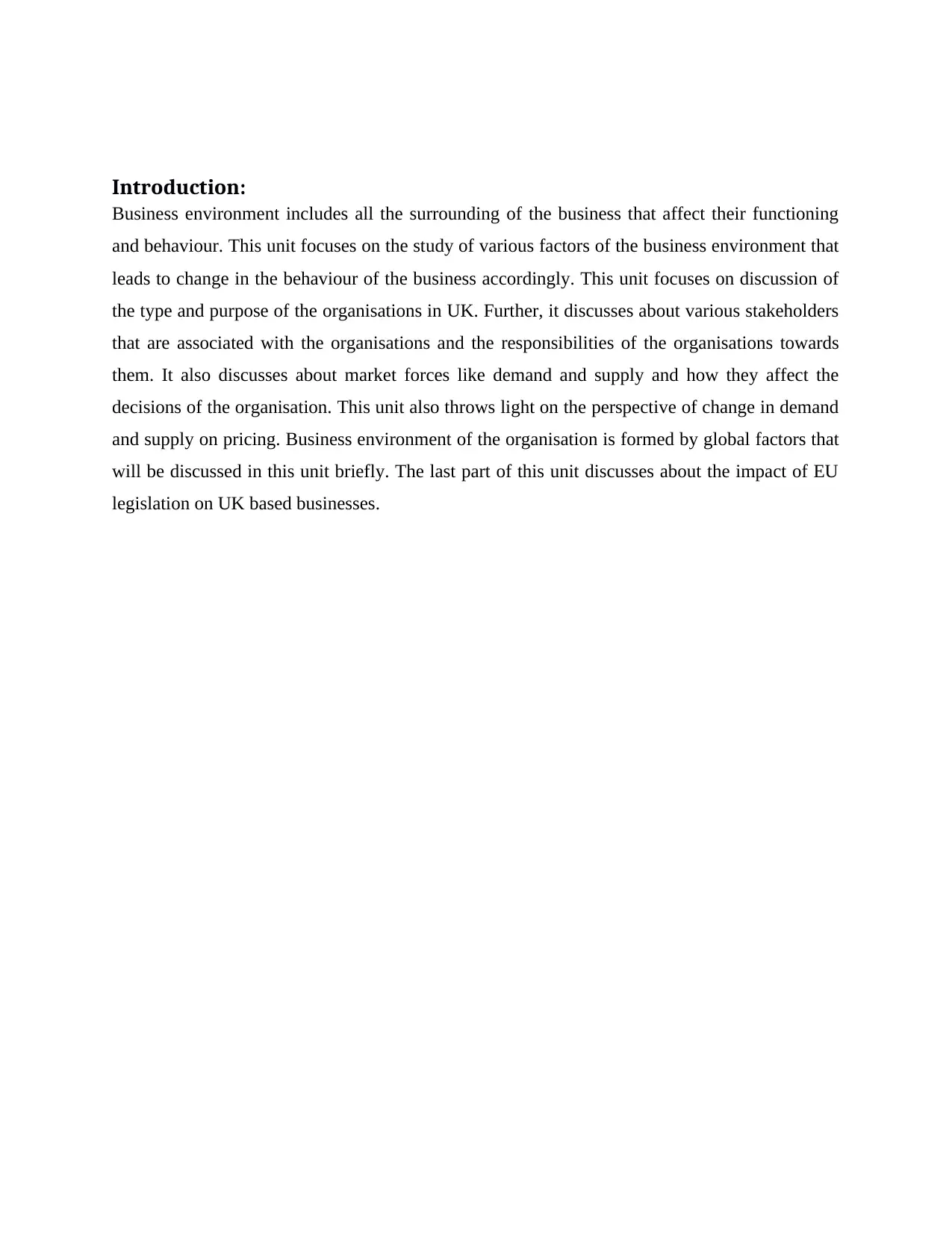
Introduction:
Business environment includes all the surrounding of the business that affect their functioning
and behaviour. This unit focuses on the study of various factors of the business environment that
leads to change in the behaviour of the business accordingly. This unit focuses on discussion of
the type and purpose of the organisations in UK. Further, it discusses about various stakeholders
that are associated with the organisations and the responsibilities of the organisations towards
them. It also discusses about market forces like demand and supply and how they affect the
decisions of the organisation. This unit also throws light on the perspective of change in demand
and supply on pricing. Business environment of the organisation is formed by global factors that
will be discussed in this unit briefly. The last part of this unit discusses about the impact of EU
legislation on UK based businesses.
Business environment includes all the surrounding of the business that affect their functioning
and behaviour. This unit focuses on the study of various factors of the business environment that
leads to change in the behaviour of the business accordingly. This unit focuses on discussion of
the type and purpose of the organisations in UK. Further, it discusses about various stakeholders
that are associated with the organisations and the responsibilities of the organisations towards
them. It also discusses about market forces like demand and supply and how they affect the
decisions of the organisation. This unit also throws light on the perspective of change in demand
and supply on pricing. Business environment of the organisation is formed by global factors that
will be discussed in this unit briefly. The last part of this unit discusses about the impact of EU
legislation on UK based businesses.
⊘ This is a preview!⊘
Do you want full access?
Subscribe today to unlock all pages.

Trusted by 1+ million students worldwide
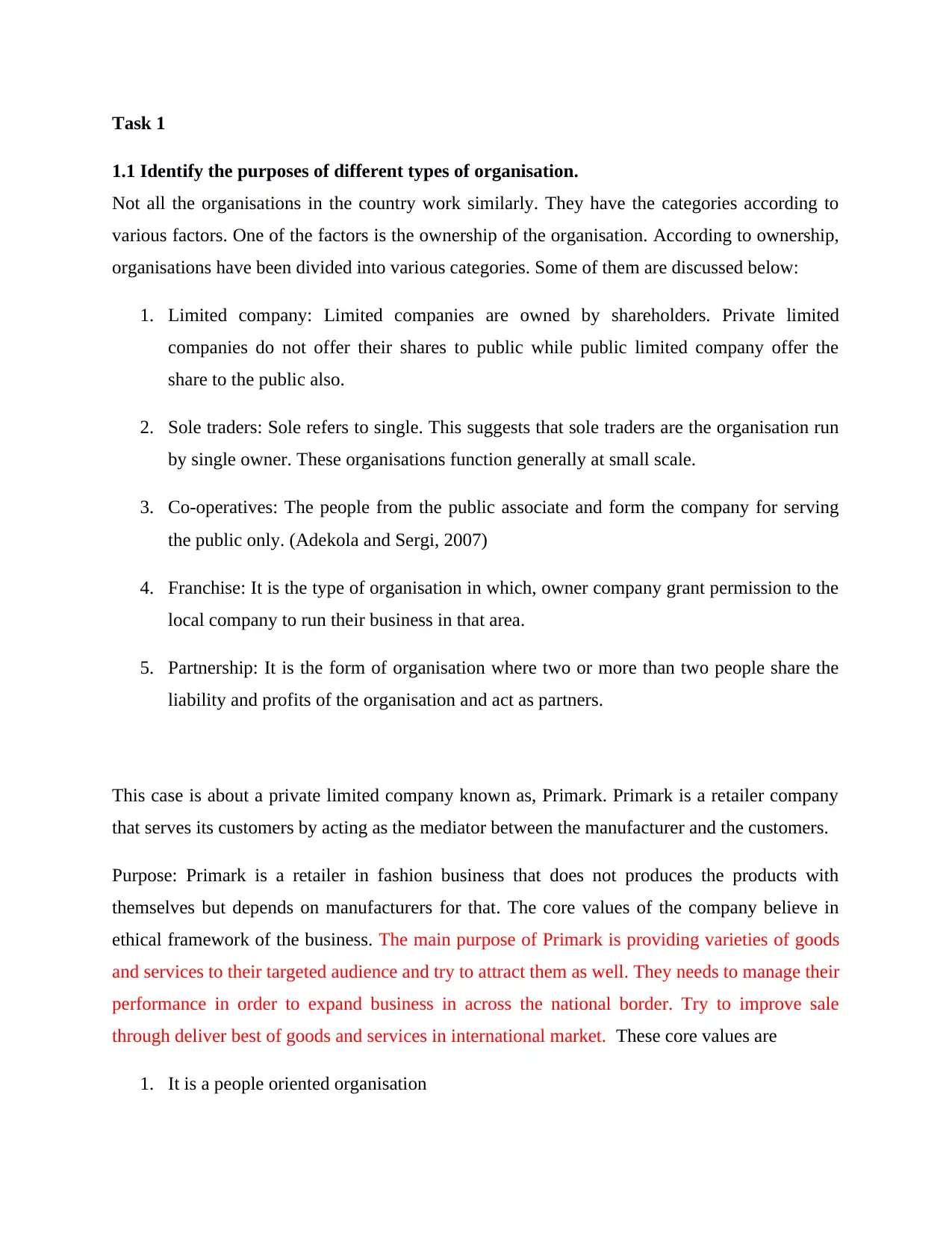
Task 1
1.1 Identify the purposes of different types of organisation.
Not all the organisations in the country work similarly. They have the categories according to
various factors. One of the factors is the ownership of the organisation. According to ownership,
organisations have been divided into various categories. Some of them are discussed below:
1. Limited company: Limited companies are owned by shareholders. Private limited
companies do not offer their shares to public while public limited company offer the
share to the public also.
2. Sole traders: Sole refers to single. This suggests that sole traders are the organisation run
by single owner. These organisations function generally at small scale.
3. Co-operatives: The people from the public associate and form the company for serving
the public only. (Adekola and Sergi, 2007)
4. Franchise: It is the type of organisation in which, owner company grant permission to the
local company to run their business in that area.
5. Partnership: It is the form of organisation where two or more than two people share the
liability and profits of the organisation and act as partners.
This case is about a private limited company known as, Primark. Primark is a retailer company
that serves its customers by acting as the mediator between the manufacturer and the customers.
Purpose: Primark is a retailer in fashion business that does not produces the products with
themselves but depends on manufacturers for that. The core values of the company believe in
ethical framework of the business. The main purpose of Primark is providing varieties of goods
and services to their targeted audience and try to attract them as well. They needs to manage their
performance in order to expand business in across the national border. Try to improve sale
through deliver best of goods and services in international market. These core values are
1. It is a people oriented organisation
1.1 Identify the purposes of different types of organisation.
Not all the organisations in the country work similarly. They have the categories according to
various factors. One of the factors is the ownership of the organisation. According to ownership,
organisations have been divided into various categories. Some of them are discussed below:
1. Limited company: Limited companies are owned by shareholders. Private limited
companies do not offer their shares to public while public limited company offer the
share to the public also.
2. Sole traders: Sole refers to single. This suggests that sole traders are the organisation run
by single owner. These organisations function generally at small scale.
3. Co-operatives: The people from the public associate and form the company for serving
the public only. (Adekola and Sergi, 2007)
4. Franchise: It is the type of organisation in which, owner company grant permission to the
local company to run their business in that area.
5. Partnership: It is the form of organisation where two or more than two people share the
liability and profits of the organisation and act as partners.
This case is about a private limited company known as, Primark. Primark is a retailer company
that serves its customers by acting as the mediator between the manufacturer and the customers.
Purpose: Primark is a retailer in fashion business that does not produces the products with
themselves but depends on manufacturers for that. The core values of the company believe in
ethical framework of the business. The main purpose of Primark is providing varieties of goods
and services to their targeted audience and try to attract them as well. They needs to manage their
performance in order to expand business in across the national border. Try to improve sale
through deliver best of goods and services in international market. These core values are
1. It is a people oriented organisation
Paraphrase This Document
Need a fresh take? Get an instant paraphrase of this document with our AI Paraphraser

2. Focuses on maintaining the ethical work environment for the employees.
3. They are not only responsible for their employees but focuses on educating the workers
working with their manufacturers.
These ethical practices by the company defines it pure objectives. Corporate Social
Responsibility is the area of work that has also been focussed by the company. (Aras and
Crowther, 2011)
Type of organisation Company name Purpose
Public limited company NHS NHS is incorporated for identify
excellent high school students. This
organisation identify those brilliant
students who are perfect in different
sectors are like scholarship, leadership
and services. Worldwide more than one
million students can participate in NHS
for improve their activities in school
time. The NHS is incorporated for not
only recognize students but also prepare
them for further challenges , improve
and develop their activities.
Charity The British Red Cross This charity firm is purely into provision
of health and support to the population
of Britain. The company aims at
providing help to the people in
emergency. The values of the company
suggest that they are courageous,
dynamic and compassionate towards
helping others.
Co-operatives Clydebank co-
operative society
Clydebank cooperative society
registered in scotland. The main purpose
of it is provide food to their consumer. It
operats six foos store. Clydebank
develop all their stores to attain its
objective. It attracts more consumer
towards their food. They want to
enhance and promote their food product
in a worldwide.
3. They are not only responsible for their employees but focuses on educating the workers
working with their manufacturers.
These ethical practices by the company defines it pure objectives. Corporate Social
Responsibility is the area of work that has also been focussed by the company. (Aras and
Crowther, 2011)
Type of organisation Company name Purpose
Public limited company NHS NHS is incorporated for identify
excellent high school students. This
organisation identify those brilliant
students who are perfect in different
sectors are like scholarship, leadership
and services. Worldwide more than one
million students can participate in NHS
for improve their activities in school
time. The NHS is incorporated for not
only recognize students but also prepare
them for further challenges , improve
and develop their activities.
Charity The British Red Cross This charity firm is purely into provision
of health and support to the population
of Britain. The company aims at
providing help to the people in
emergency. The values of the company
suggest that they are courageous,
dynamic and compassionate towards
helping others.
Co-operatives Clydebank co-
operative society
Clydebank cooperative society
registered in scotland. The main purpose
of it is provide food to their consumer. It
operats six foos store. Clydebank
develop all their stores to attain its
objective. It attracts more consumer
towards their food. They want to
enhance and promote their food product
in a worldwide.
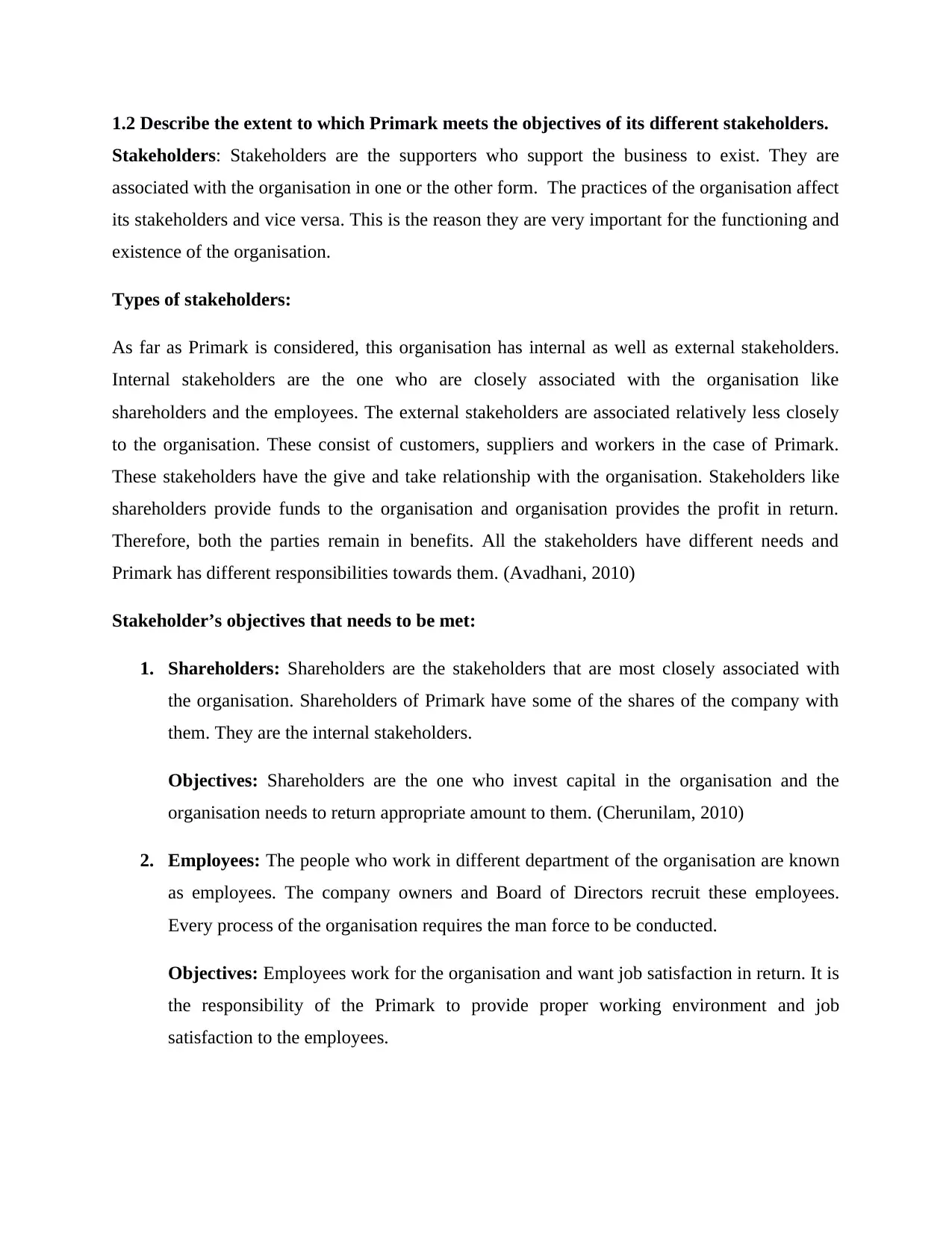
1.2 Describe the extent to which Primark meets the objectives of its different stakeholders.
Stakeholders: Stakeholders are the supporters who support the business to exist. They are
associated with the organisation in one or the other form. The practices of the organisation affect
its stakeholders and vice versa. This is the reason they are very important for the functioning and
existence of the organisation.
Types of stakeholders:
As far as Primark is considered, this organisation has internal as well as external stakeholders.
Internal stakeholders are the one who are closely associated with the organisation like
shareholders and the employees. The external stakeholders are associated relatively less closely
to the organisation. These consist of customers, suppliers and workers in the case of Primark.
These stakeholders have the give and take relationship with the organisation. Stakeholders like
shareholders provide funds to the organisation and organisation provides the profit in return.
Therefore, both the parties remain in benefits. All the stakeholders have different needs and
Primark has different responsibilities towards them. (Avadhani, 2010)
Stakeholder’s objectives that needs to be met:
1. Shareholders: Shareholders are the stakeholders that are most closely associated with
the organisation. Shareholders of Primark have some of the shares of the company with
them. They are the internal stakeholders.
Objectives: Shareholders are the one who invest capital in the organisation and the
organisation needs to return appropriate amount to them. (Cherunilam, 2010)
2. Employees: The people who work in different department of the organisation are known
as employees. The company owners and Board of Directors recruit these employees.
Every process of the organisation requires the man force to be conducted.
Objectives: Employees work for the organisation and want job satisfaction in return. It is
the responsibility of the Primark to provide proper working environment and job
satisfaction to the employees.
Stakeholders: Stakeholders are the supporters who support the business to exist. They are
associated with the organisation in one or the other form. The practices of the organisation affect
its stakeholders and vice versa. This is the reason they are very important for the functioning and
existence of the organisation.
Types of stakeholders:
As far as Primark is considered, this organisation has internal as well as external stakeholders.
Internal stakeholders are the one who are closely associated with the organisation like
shareholders and the employees. The external stakeholders are associated relatively less closely
to the organisation. These consist of customers, suppliers and workers in the case of Primark.
These stakeholders have the give and take relationship with the organisation. Stakeholders like
shareholders provide funds to the organisation and organisation provides the profit in return.
Therefore, both the parties remain in benefits. All the stakeholders have different needs and
Primark has different responsibilities towards them. (Avadhani, 2010)
Stakeholder’s objectives that needs to be met:
1. Shareholders: Shareholders are the stakeholders that are most closely associated with
the organisation. Shareholders of Primark have some of the shares of the company with
them. They are the internal stakeholders.
Objectives: Shareholders are the one who invest capital in the organisation and the
organisation needs to return appropriate amount to them. (Cherunilam, 2010)
2. Employees: The people who work in different department of the organisation are known
as employees. The company owners and Board of Directors recruit these employees.
Every process of the organisation requires the man force to be conducted.
Objectives: Employees work for the organisation and want job satisfaction in return. It is
the responsibility of the Primark to provide proper working environment and job
satisfaction to the employees.
⊘ This is a preview!⊘
Do you want full access?
Subscribe today to unlock all pages.

Trusted by 1+ million students worldwide
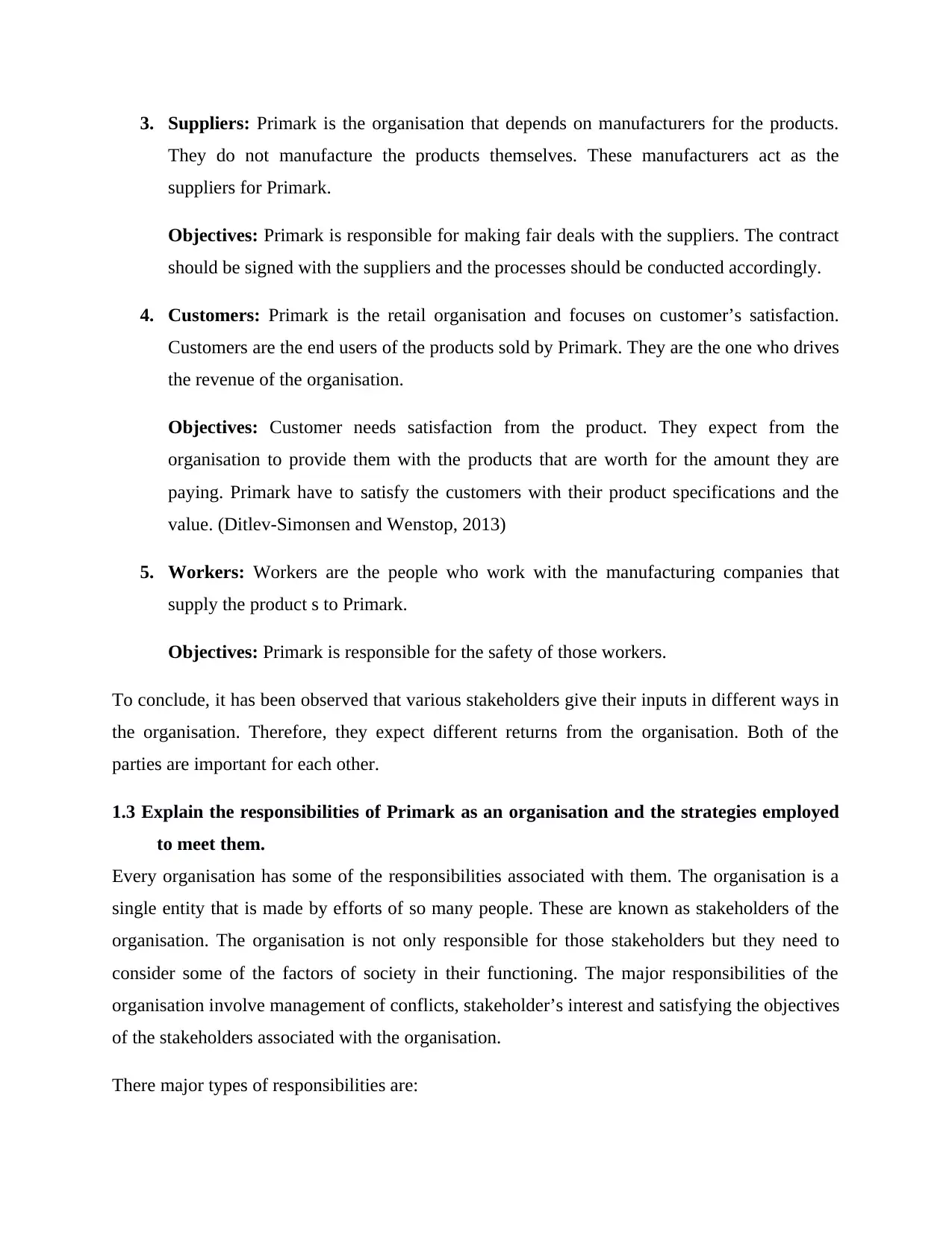
3. Suppliers: Primark is the organisation that depends on manufacturers for the products.
They do not manufacture the products themselves. These manufacturers act as the
suppliers for Primark.
Objectives: Primark is responsible for making fair deals with the suppliers. The contract
should be signed with the suppliers and the processes should be conducted accordingly.
4. Customers: Primark is the retail organisation and focuses on customer’s satisfaction.
Customers are the end users of the products sold by Primark. They are the one who drives
the revenue of the organisation.
Objectives: Customer needs satisfaction from the product. They expect from the
organisation to provide them with the products that are worth for the amount they are
paying. Primark have to satisfy the customers with their product specifications and the
value. (Ditlev-Simonsen and Wenstop, 2013)
5. Workers: Workers are the people who work with the manufacturing companies that
supply the product s to Primark.
Objectives: Primark is responsible for the safety of those workers.
To conclude, it has been observed that various stakeholders give their inputs in different ways in
the organisation. Therefore, they expect different returns from the organisation. Both of the
parties are important for each other.
1.3 Explain the responsibilities of Primark as an organisation and the strategies employed
to meet them.
Every organisation has some of the responsibilities associated with them. The organisation is a
single entity that is made by efforts of so many people. These are known as stakeholders of the
organisation. The organisation is not only responsible for those stakeholders but they need to
consider some of the factors of society in their functioning. The major responsibilities of the
organisation involve management of conflicts, stakeholder’s interest and satisfying the objectives
of the stakeholders associated with the organisation.
There major types of responsibilities are:
They do not manufacture the products themselves. These manufacturers act as the
suppliers for Primark.
Objectives: Primark is responsible for making fair deals with the suppliers. The contract
should be signed with the suppliers and the processes should be conducted accordingly.
4. Customers: Primark is the retail organisation and focuses on customer’s satisfaction.
Customers are the end users of the products sold by Primark. They are the one who drives
the revenue of the organisation.
Objectives: Customer needs satisfaction from the product. They expect from the
organisation to provide them with the products that are worth for the amount they are
paying. Primark have to satisfy the customers with their product specifications and the
value. (Ditlev-Simonsen and Wenstop, 2013)
5. Workers: Workers are the people who work with the manufacturing companies that
supply the product s to Primark.
Objectives: Primark is responsible for the safety of those workers.
To conclude, it has been observed that various stakeholders give their inputs in different ways in
the organisation. Therefore, they expect different returns from the organisation. Both of the
parties are important for each other.
1.3 Explain the responsibilities of Primark as an organisation and the strategies employed
to meet them.
Every organisation has some of the responsibilities associated with them. The organisation is a
single entity that is made by efforts of so many people. These are known as stakeholders of the
organisation. The organisation is not only responsible for those stakeholders but they need to
consider some of the factors of society in their functioning. The major responsibilities of the
organisation involve management of conflicts, stakeholder’s interest and satisfying the objectives
of the stakeholders associated with the organisation.
There major types of responsibilities are:
Paraphrase This Document
Need a fresh take? Get an instant paraphrase of this document with our AI Paraphraser

Some of the legal factors are also associated with the responsibilities of the organisation.
Organisations need to make the policies considering all the legislations that include
discriminatory Act, environmental Act etc. Ethical considerations are also important for the
organisations to perform their responsibility tasks. (Friedman and Miles, 2006)
Responsibilities of Primark:
1. Towards stakeholders: All the stakeholders like shareholders, employees, customers,
suppliers etc have different objectives to be associated with the organisation. Primark has
the responsibility to fulfil those objectives in return.
2. Legislations: Organisations in UK are bound to make the policies according to the legal
legislations framed by the government. It is the responsibility of Primark to frame all the
policies considering the legislations of the country.
3. Towards society: Society is major part to be considered. All the organisations have the
main responsibility towards the organisations. CSR is the most important practice that
focuses on returning something to the society by the organisations. Primark engaged in
many CSR activities to return to the society. (Hill, 2008)
Strategies of Primark:
Primark is the company that sticks to its values and beliefs in order to be responsible. The first
strategy of Primark to be responsible towards its employees is determined by its values. The
value of the company suggests providing fair and equal treatment to all the employees. Another
strategy of the company is to be ethical in practices and behaviour. The company is engaged with
many CSR activities in order to fulfil their responsibilities towards the society. The HER project
of the company focuses on educating the women workers of the company about the important of
maintenance of health and hygiene. This education can be transferred to the families of these
workers and in turn benefits the society. (Businesscasestudies.co.uk, 2016)
Organisations need to make the policies considering all the legislations that include
discriminatory Act, environmental Act etc. Ethical considerations are also important for the
organisations to perform their responsibility tasks. (Friedman and Miles, 2006)
Responsibilities of Primark:
1. Towards stakeholders: All the stakeholders like shareholders, employees, customers,
suppliers etc have different objectives to be associated with the organisation. Primark has
the responsibility to fulfil those objectives in return.
2. Legislations: Organisations in UK are bound to make the policies according to the legal
legislations framed by the government. It is the responsibility of Primark to frame all the
policies considering the legislations of the country.
3. Towards society: Society is major part to be considered. All the organisations have the
main responsibility towards the organisations. CSR is the most important practice that
focuses on returning something to the society by the organisations. Primark engaged in
many CSR activities to return to the society. (Hill, 2008)
Strategies of Primark:
Primark is the company that sticks to its values and beliefs in order to be responsible. The first
strategy of Primark to be responsible towards its employees is determined by its values. The
value of the company suggests providing fair and equal treatment to all the employees. Another
strategy of the company is to be ethical in practices and behaviour. The company is engaged with
many CSR activities in order to fulfil their responsibilities towards the society. The HER project
of the company focuses on educating the women workers of the company about the important of
maintenance of health and hygiene. This education can be transferred to the families of these
workers and in turn benefits the society. (Businesscasestudies.co.uk, 2016)
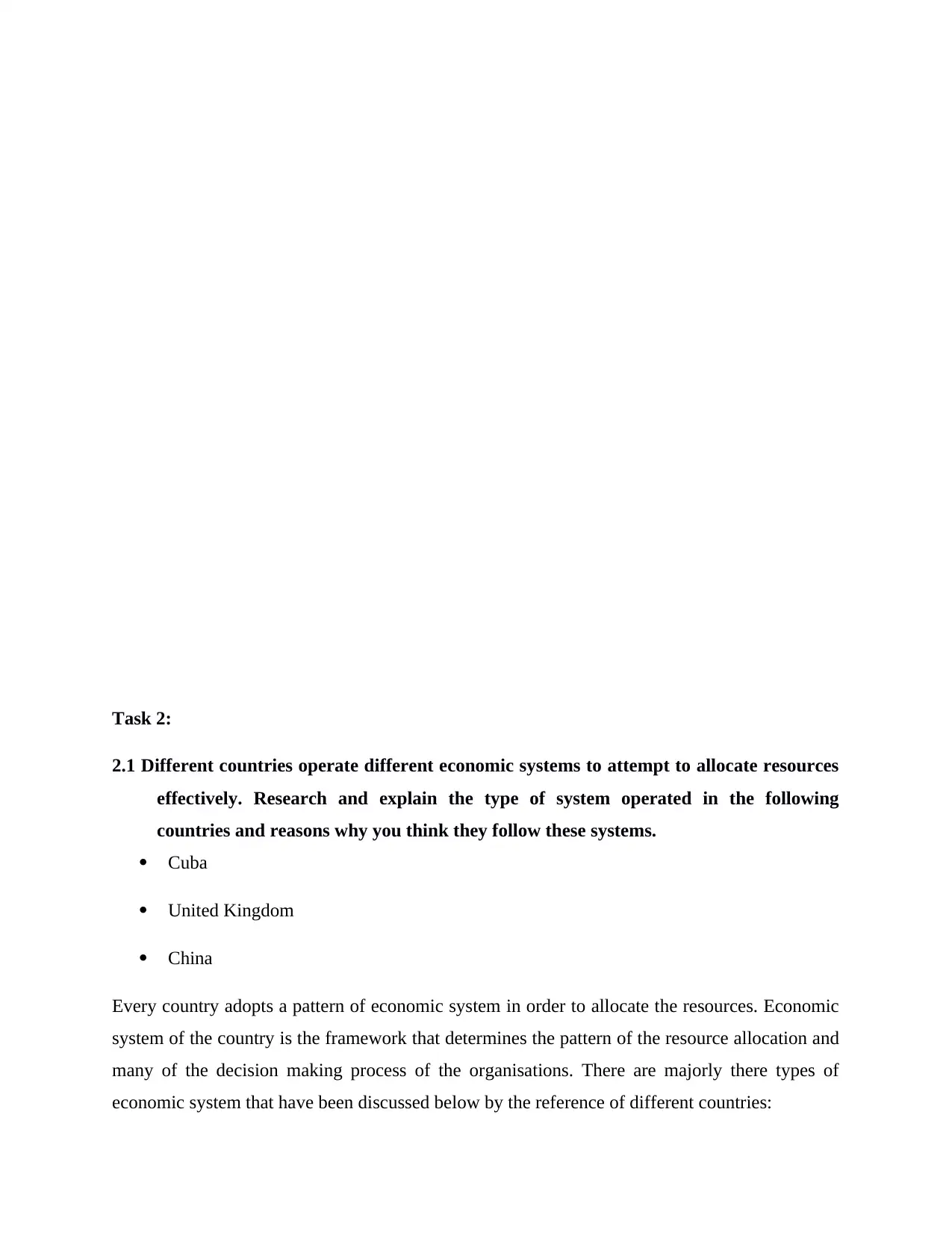
Task 2:
2.1 Different countries operate different economic systems to attempt to allocate resources
effectively. Research and explain the type of system operated in the following
countries and reasons why you think they follow these systems.
Cuba
United Kingdom
China
Every country adopts a pattern of economic system in order to allocate the resources. Economic
system of the country is the framework that determines the pattern of the resource allocation and
many of the decision making process of the organisations. There are majorly there types of
economic system that have been discussed below by the reference of different countries:
2.1 Different countries operate different economic systems to attempt to allocate resources
effectively. Research and explain the type of system operated in the following
countries and reasons why you think they follow these systems.
Cuba
United Kingdom
China
Every country adopts a pattern of economic system in order to allocate the resources. Economic
system of the country is the framework that determines the pattern of the resource allocation and
many of the decision making process of the organisations. There are majorly there types of
economic system that have been discussed below by the reference of different countries:
⊘ This is a preview!⊘
Do you want full access?
Subscribe today to unlock all pages.

Trusted by 1+ million students worldwide
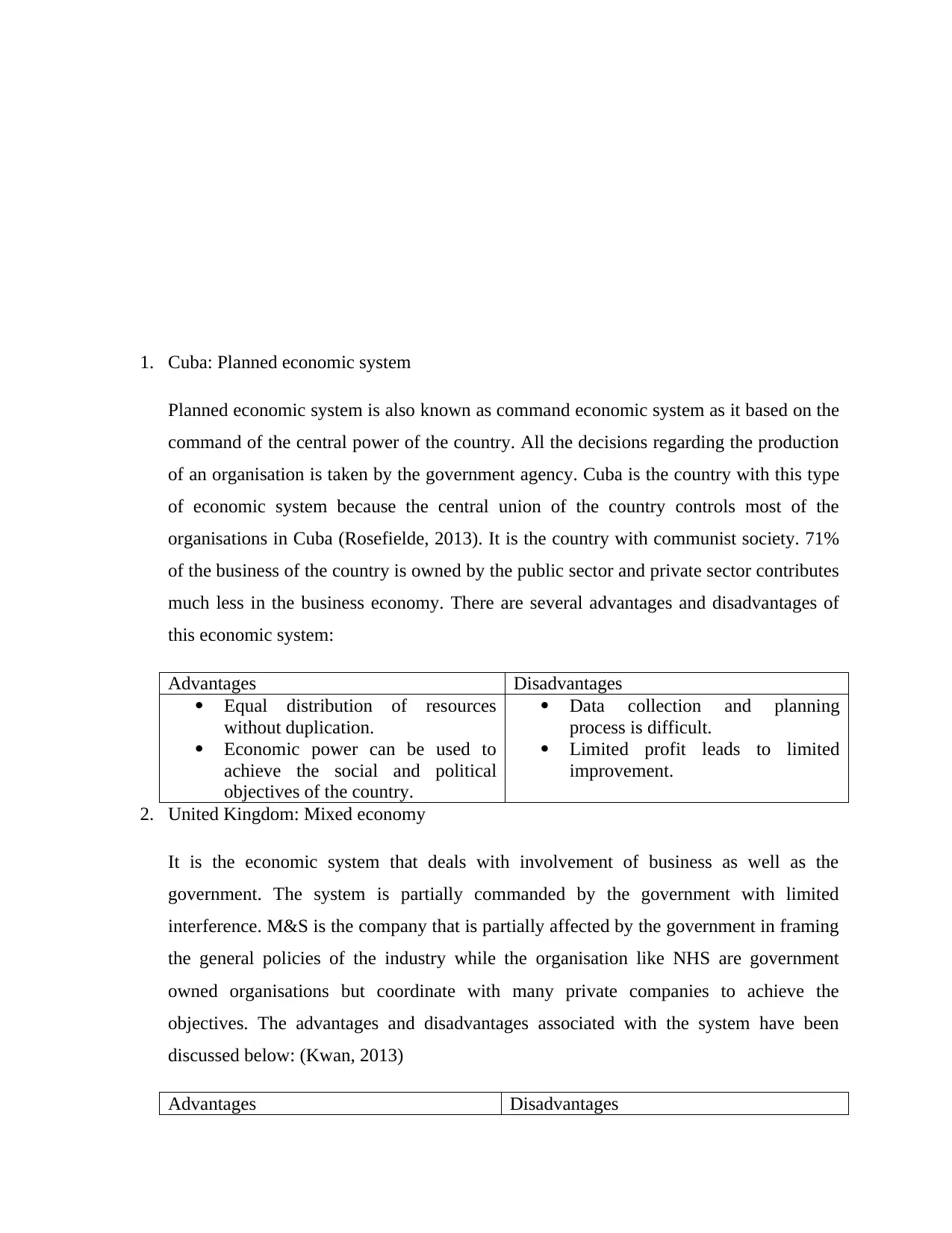
1. Cuba: Planned economic system
Planned economic system is also known as command economic system as it based on the
command of the central power of the country. All the decisions regarding the production
of an organisation is taken by the government agency. Cuba is the country with this type
of economic system because the central union of the country controls most of the
organisations in Cuba (Rosefielde, 2013). It is the country with communist society. 71%
of the business of the country is owned by the public sector and private sector contributes
much less in the business economy. There are several advantages and disadvantages of
this economic system:
Advantages Disadvantages
Equal distribution of resources
without duplication.
Economic power can be used to
achieve the social and political
objectives of the country.
Data collection and planning
process is difficult.
Limited profit leads to limited
improvement.
2. United Kingdom: Mixed economy
It is the economic system that deals with involvement of business as well as the
government. The system is partially commanded by the government with limited
interference. M&S is the company that is partially affected by the government in framing
the general policies of the industry while the organisation like NHS are government
owned organisations but coordinate with many private companies to achieve the
objectives. The advantages and disadvantages associated with the system have been
discussed below: (Kwan, 2013)
Advantages Disadvantages
Planned economic system is also known as command economic system as it based on the
command of the central power of the country. All the decisions regarding the production
of an organisation is taken by the government agency. Cuba is the country with this type
of economic system because the central union of the country controls most of the
organisations in Cuba (Rosefielde, 2013). It is the country with communist society. 71%
of the business of the country is owned by the public sector and private sector contributes
much less in the business economy. There are several advantages and disadvantages of
this economic system:
Advantages Disadvantages
Equal distribution of resources
without duplication.
Economic power can be used to
achieve the social and political
objectives of the country.
Data collection and planning
process is difficult.
Limited profit leads to limited
improvement.
2. United Kingdom: Mixed economy
It is the economic system that deals with involvement of business as well as the
government. The system is partially commanded by the government with limited
interference. M&S is the company that is partially affected by the government in framing
the general policies of the industry while the organisation like NHS are government
owned organisations but coordinate with many private companies to achieve the
objectives. The advantages and disadvantages associated with the system have been
discussed below: (Kwan, 2013)
Advantages Disadvantages
Paraphrase This Document
Need a fresh take? Get an instant paraphrase of this document with our AI Paraphraser
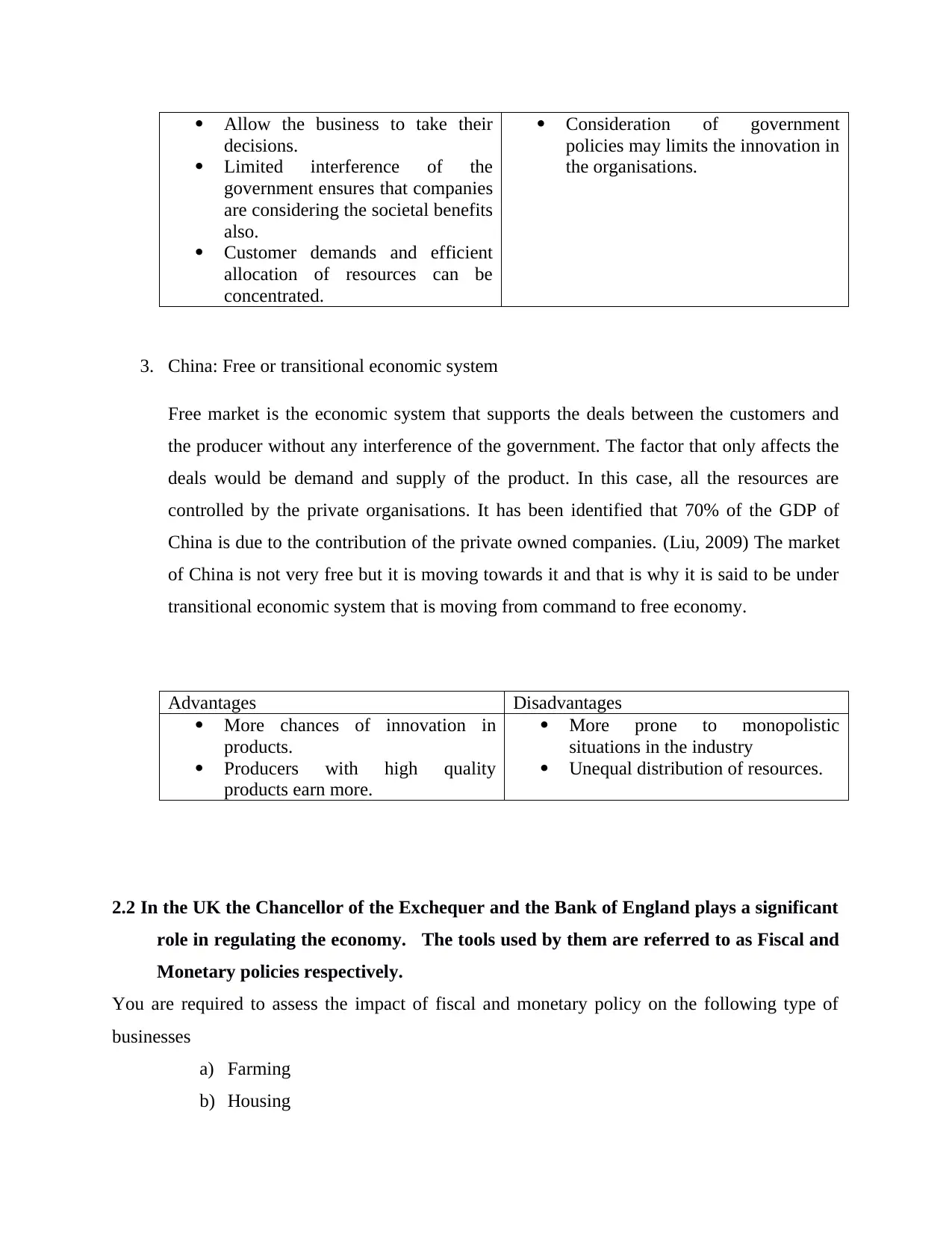
Allow the business to take their
decisions.
Limited interference of the
government ensures that companies
are considering the societal benefits
also.
Customer demands and efficient
allocation of resources can be
concentrated.
Consideration of government
policies may limits the innovation in
the organisations.
3. China: Free or transitional economic system
Free market is the economic system that supports the deals between the customers and
the producer without any interference of the government. The factor that only affects the
deals would be demand and supply of the product. In this case, all the resources are
controlled by the private organisations. It has been identified that 70% of the GDP of
China is due to the contribution of the private owned companies. (Liu, 2009) The market
of China is not very free but it is moving towards it and that is why it is said to be under
transitional economic system that is moving from command to free economy.
Advantages Disadvantages
More chances of innovation in
products.
Producers with high quality
products earn more.
More prone to monopolistic
situations in the industry
Unequal distribution of resources.
2.2 In the UK the Chancellor of the Exchequer and the Bank of England plays a significant
role in regulating the economy. The tools used by them are referred to as Fiscal and
Monetary policies respectively.
You are required to assess the impact of fiscal and monetary policy on the following type of
businesses
a) Farming
b) Housing
decisions.
Limited interference of the
government ensures that companies
are considering the societal benefits
also.
Customer demands and efficient
allocation of resources can be
concentrated.
Consideration of government
policies may limits the innovation in
the organisations.
3. China: Free or transitional economic system
Free market is the economic system that supports the deals between the customers and
the producer without any interference of the government. The factor that only affects the
deals would be demand and supply of the product. In this case, all the resources are
controlled by the private organisations. It has been identified that 70% of the GDP of
China is due to the contribution of the private owned companies. (Liu, 2009) The market
of China is not very free but it is moving towards it and that is why it is said to be under
transitional economic system that is moving from command to free economy.
Advantages Disadvantages
More chances of innovation in
products.
Producers with high quality
products earn more.
More prone to monopolistic
situations in the industry
Unequal distribution of resources.
2.2 In the UK the Chancellor of the Exchequer and the Bank of England plays a significant
role in regulating the economy. The tools used by them are referred to as Fiscal and
Monetary policies respectively.
You are required to assess the impact of fiscal and monetary policy on the following type of
businesses
a) Farming
b) Housing
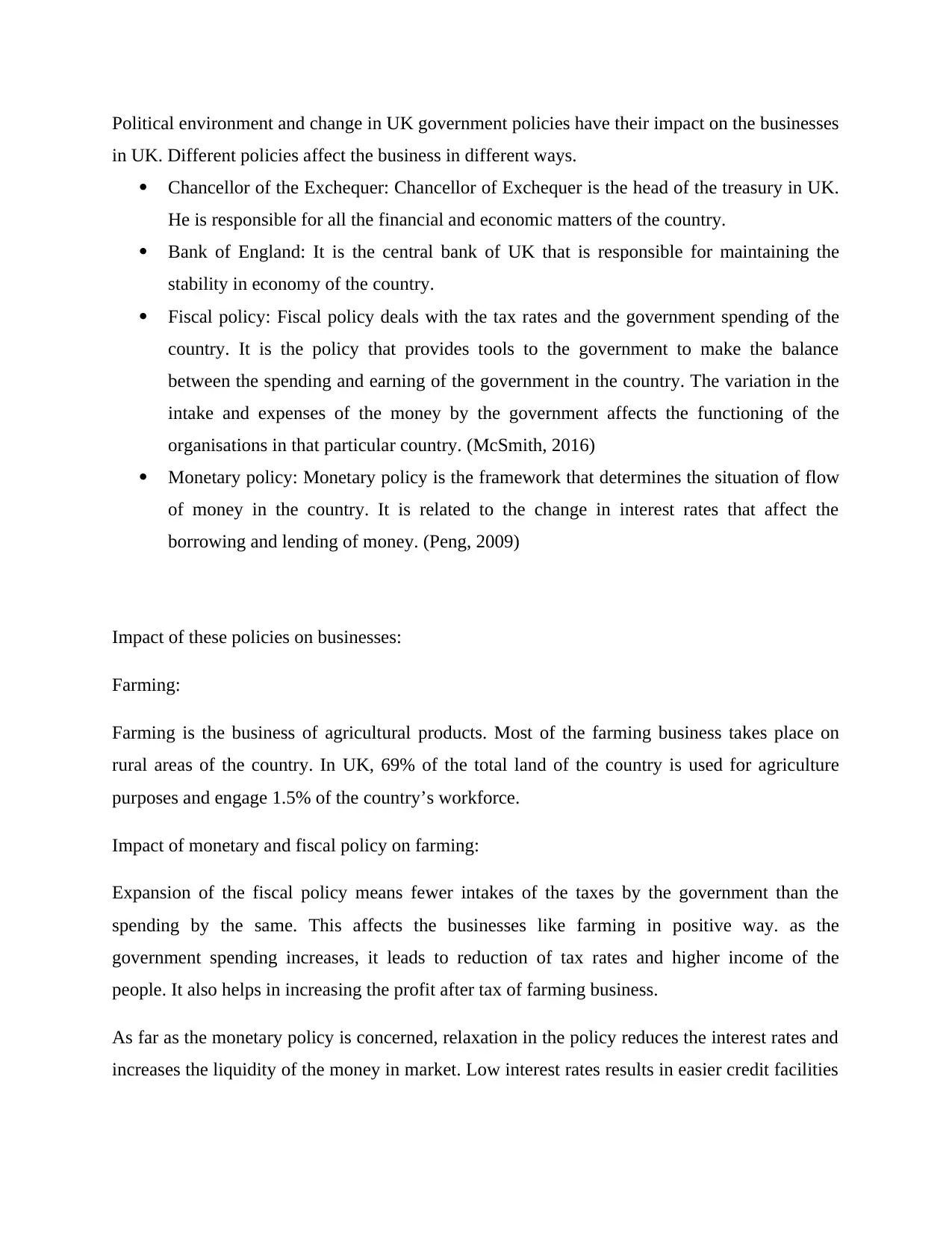
Political environment and change in UK government policies have their impact on the businesses
in UK. Different policies affect the business in different ways.
Chancellor of the Exchequer: Chancellor of Exchequer is the head of the treasury in UK.
He is responsible for all the financial and economic matters of the country.
Bank of England: It is the central bank of UK that is responsible for maintaining the
stability in economy of the country.
Fiscal policy: Fiscal policy deals with the tax rates and the government spending of the
country. It is the policy that provides tools to the government to make the balance
between the spending and earning of the government in the country. The variation in the
intake and expenses of the money by the government affects the functioning of the
organisations in that particular country. (McSmith, 2016)
Monetary policy: Monetary policy is the framework that determines the situation of flow
of money in the country. It is related to the change in interest rates that affect the
borrowing and lending of money. (Peng, 2009)
Impact of these policies on businesses:
Farming:
Farming is the business of agricultural products. Most of the farming business takes place on
rural areas of the country. In UK, 69% of the total land of the country is used for agriculture
purposes and engage 1.5% of the country’s workforce.
Impact of monetary and fiscal policy on farming:
Expansion of the fiscal policy means fewer intakes of the taxes by the government than the
spending by the same. This affects the businesses like farming in positive way. as the
government spending increases, it leads to reduction of tax rates and higher income of the
people. It also helps in increasing the profit after tax of farming business.
As far as the monetary policy is concerned, relaxation in the policy reduces the interest rates and
increases the liquidity of the money in market. Low interest rates results in easier credit facilities
in UK. Different policies affect the business in different ways.
Chancellor of the Exchequer: Chancellor of Exchequer is the head of the treasury in UK.
He is responsible for all the financial and economic matters of the country.
Bank of England: It is the central bank of UK that is responsible for maintaining the
stability in economy of the country.
Fiscal policy: Fiscal policy deals with the tax rates and the government spending of the
country. It is the policy that provides tools to the government to make the balance
between the spending and earning of the government in the country. The variation in the
intake and expenses of the money by the government affects the functioning of the
organisations in that particular country. (McSmith, 2016)
Monetary policy: Monetary policy is the framework that determines the situation of flow
of money in the country. It is related to the change in interest rates that affect the
borrowing and lending of money. (Peng, 2009)
Impact of these policies on businesses:
Farming:
Farming is the business of agricultural products. Most of the farming business takes place on
rural areas of the country. In UK, 69% of the total land of the country is used for agriculture
purposes and engage 1.5% of the country’s workforce.
Impact of monetary and fiscal policy on farming:
Expansion of the fiscal policy means fewer intakes of the taxes by the government than the
spending by the same. This affects the businesses like farming in positive way. as the
government spending increases, it leads to reduction of tax rates and higher income of the
people. It also helps in increasing the profit after tax of farming business.
As far as the monetary policy is concerned, relaxation in the policy reduces the interest rates and
increases the liquidity of the money in market. Low interest rates results in easier credit facilities
⊘ This is a preview!⊘
Do you want full access?
Subscribe today to unlock all pages.

Trusted by 1+ million students worldwide
1 out of 28